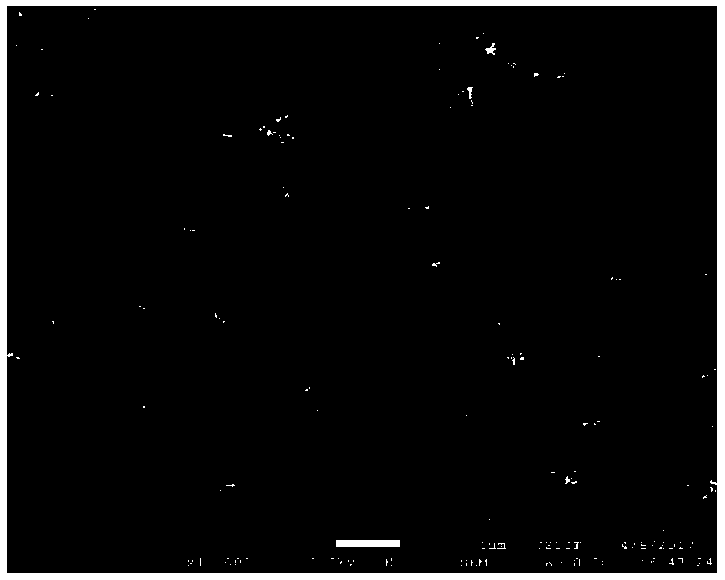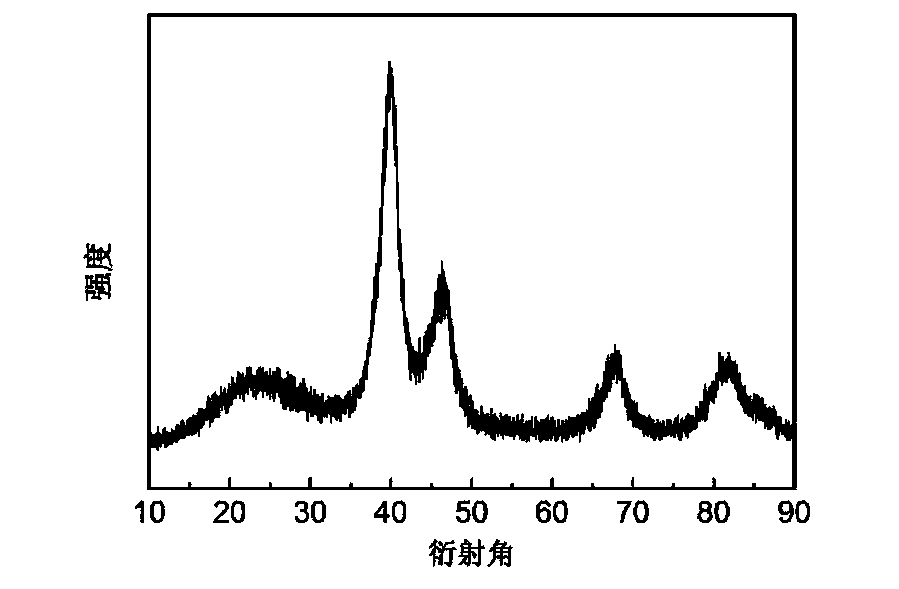Supported low-platinum core-shell catalyst and preparation and appliation thereof
A core-shell catalyst, supported technology, applied in electrical components, battery electrodes, circuits, etc., can solve the problem of low utilization rate of platinum, and achieve the effects of high utilization rate, uniform distribution, and low load.
- Summary
- Abstract
- Description
- Claims
- Application Information
AI Technical Summary
Problems solved by technology
Method used
Image
Examples
Embodiment 1
[0028] At 20°C, dissolve 1.470g of zinc nitrate hexahydrate and 0.74g of cobalt nitrate hexahydrate in 100ml of methanol, and dissolve 3.260 of 2-methylimidazole in 100ml of methanol. The former is slowly added to the latter under stirring, and the stirring is continued. 12min, then stand for 20h. Centrifuge, wash three times, and dry in vacuum at 150°C for 8 hours to obtain Zn 0.95 co 0.05 -ZIF8. Take 1gZn 0.95 co 0.05 -ZIF8 was placed in a corundum boat, heated to 900°C at a heating rate of 2°C / min and kept for 2 hours, then cooled to room temperature at a cooling rate of 5°C / min to take out the porous carbon support. Disperse 100mg of porous carbon carrier in 100mL of deionized water, pass through nitrogen protection, sonicate for half an hour, then add 10ml100μg mL dropwise -1 The chloroplatinic acid aqueous solution was continuously stirred for 8 hours, and the catalyst was obtained by suction filtration under reduced pressure, washed with 1 L of deionized water, and...
Embodiment 2
[0031] At 20°C, dissolve 1.470g of zinc nitrate hexahydrate and 0.147g of cobalt nitrate hexahydrate in 100ml of methanol, and dissolve 3.260g of 2-methylimidazole in 100ml of methanol. The former is slowly added to the latter under stirring, and the stirring is continued. 12min, then stand for 20h. Centrifuge, wash three times, and dry in vacuum at 150°C for 8 hours to obtain Zn 0.9 co 0.1 -ZIF8. Take 1gZn 0.95 co 0.05 -ZIF8 was placed in a corundum boat, heated to 900°C at a heating rate of 2°C / min and kept for 2 hours, then cooled to room temperature at a cooling rate of 5°C / min to take out the porous carbon support. Disperse 100mg of porous carbon carrier in 100mL of deionized water, pass through nitrogen protection, sonicate for half an hour, then add 10ml of 100μg mL dropwise -1 The chloroplatinic acid aqueous solution was continuously stirred for 8 hours, and the catalyst was obtained by suction filtration under reduced pressure, washed with 1 L of deionized water,...
Embodiment 3
[0033] At 20°C, dissolve 1.470g of zinc nitrate hexahydrate and 0.74g of ferric nitrate hexahydrate in 100ml of methanol, and dissolve 3.26g of 2-methylimidazole in 100ml of methanol. The former is slowly added to the latter under stirring, and the stirring is continued. 12min, then stand for 20h. Centrifuge, wash three times, and dry in vacuum at 150°C for 8 hours to obtain Zn 0.95 co0.05 -ZIF8. Take 1gZn 0.95 co 0.05 -ZIF8 was placed in a corundum boat, heated to 900°C at a heating rate of 2°C / min and kept for 2 hours, then cooled to room temperature at a cooling rate of 5°C / min to take out the porous carbon support. Disperse 100mg of porous carbon carrier in 100mL of deionized water, pass through nitrogen protection, sonicate for half an hour, then add 10ml of 100μg mL dropwise -1 The chloroplatinic acid aqueous solution was continuously stirred for 8 hours, and the catalyst was obtained by suction filtration under reduced pressure, washed with 1 L of deionized water, a...
PUM
| Property | Measurement | Unit |
|---|---|---|
| Outer diameter | aaaaa | aaaaa |
| Diameter | aaaaa | aaaaa |
Abstract
Description
Claims
Application Information
 Login to View More
Login to View More - R&D Engineer
- R&D Manager
- IP Professional
- Industry Leading Data Capabilities
- Powerful AI technology
- Patent DNA Extraction
Browse by: Latest US Patents, China's latest patents, Technical Efficacy Thesaurus, Application Domain, Technology Topic, Popular Technical Reports.
© 2024 PatSnap. All rights reserved.Legal|Privacy policy|Modern Slavery Act Transparency Statement|Sitemap|About US| Contact US: help@patsnap.com










